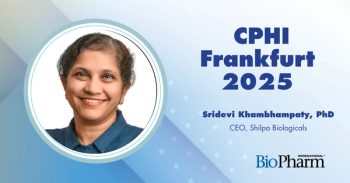
- BioPharm International-04-02-2009
- Volume 2009 Supplement
- Issue 3
Strategies for Sourcing Animal-Origin Free Cell Culture Media Components
How to successfully balance patient safety with supply-chain management
Abstract
Following cases of mycoplasma contamination in the 1970s, endotoxin concerns in the 1980s, and bovine spongiform encephalopathy (BSE) scares in the 1990s, the biopharmaceutical industry continues to push for thorough and transparent information about the origin of raw materials used in the manufacture of therapeutics. In particular, companies often ask cell culture media suppliers for documentation of the animal-origin free (AOF) status of media and reagent components. Many biotherapeutics manufacturers have begun applying varying definitions and standards of AOF, however, depending on the regulatory authorities they work with and their own level of concern; many companies also have begun to demand detailed information about the complete supply chain of components used in media and reagents. The consequences of these in-depth investigations can be significant in terms of the cost and availability of materials. To help navigate what is possible and practical, this article reviews the levels of inquiry required for selecting AOF cell culture components; how to qualify and validate the claims; and finally, ways to help balance risks with patient safety without affecting product availability.
Concern about the risk of animal-derived transmissible spongiform encephalopathies (TSE) has long been a driver for biopharmaceutical companies to eliminate animal origin (AO) materials from their cell culture processes.1 This trend has prompted research by manufacturers of cell culture media into producing media that can maintain productivity without using animal-derived serum, proteins, or lipids.2,3 To reduce the risk of known contaminants such as BSE and yet unknown agents, biopharmaceutical companies are pushing cell culture manufacturers to take increased levels of care in choosing raw materials for their products.
PNC/Getty Images
The term animal-origin free (AOF) generally is used by cell culture component suppliers to refer to any components not directly derived from eukaryotic animals (excluding higher plants, fungi, protozoa, and algae). This level of animal-origin free is known as primary level AOF. Currently, there is no standard industry definition that addresses the status of the lower life forms listed in the animal kingdom (e.g., sponges, worms, insects), although some biopharmaceutical companies define an animal source as any multicellular form with specialized eukaryotic cells that have their own means of locomotion. This raises the question of what the definition of animal should be in this case.
In addition, media suppliers are now being asked to provide cell culture media in which all the components of the cell culture media meet the standard of secondary level AOF. This term has no universal definition, but for the purposes of this article, secondary level AOF will be used to refer to media components that have been manufactured without the use of products derived directly from animals. For example, if a protein component has been manufactured using recombinant E. coli grown in a culture containing no animal-based peptones, the component is classified as secondary level AOF.
As suppliers and manufacturers have gained a better understanding of the media manufacturing process and how to remove AO components, the desire has emerged to go even further. The most challenging standard of AOF is the tertiary level, which requires media manufacturers to ensure that none of the components used to manufacture the raw materials are derived from an animal. In practice, this would mean that the protein in the example above would only be considered tertiary AOF if the AOF peptone were derived from a recombinant process in which none of the ingredients in the broth used to make the peptone were directly derived from an animal.
It is good that the precise AOF status of media components be understood and documented, and that there be a high level of transparency regarding manufacturing change for raw materials. It should be noted, however, there have been no indications that AO materials at the tertiary level constitute any safety hazard in cell culture–based pharmaceutical products. To provide anything above the secondary level of AOF requires a significant audit trail including reviews of bill of materials and various manufacturing steps, which are currently not specifically required by any regulatory agency. Currently, tertiary level AOF components are not being actively demanded by many manufacturers of biotherapeutics mainly because of how difficult it is to establish, control, monitor, and maintain supplies of such products.
In addition, requiring tertiary level AOF media severely restricts the possible sources. As shown in Figure 1, one media supplier has made an effort over the past decade to qualify secondary AOF components, and in doing so, has made progress in achieving a higher level of AOF status for many components. Clearly, the higher biopharmaceutical manufacturers raise the bar for AOF status, the fewer components will qualify for use in their media.
Figure 1
What Levels of AOF are Achievable? A Practical Example
Insulin is widely used in mammalian cell culture to delay apoptosis and thereby increase productivity. In the past 20 years, because methods of producing recombinant human insulin have come to the forefront, there has been a shift away from using bovine- or porcine-derived insulin.4 Recombinant insulin is generally a primary level AOF component. However, as worries about TSE and other animal-origin contaminants have increased, many biopharmaceutical companies have begun to ask media suppliers to consider producing secondary level AOF insulin, even though the therapeutic standard insulin that patients receive as an injectable remains primary level AOF.
Cell culture media suppliers have responded by ensuring that the cell lines they use to produce insulin are cultured in AOF media. However, one of the greatest stumbling blocks to producing secondary level AOF insulin is at the step where pro-insulin is cleaved to produce active insulin (Figure 2). One of the enzymes used in the cleavage is trypsin, which is traditionally derived from bovine or porcine sources.
Figure 2
Currently, one major insulin manufacturer is using a recombinant form of non-animal derived trypsin to produce a secondary level AOF insulin for bioprocess use. This secondary level AOF version is more expensive and less readily available than primary level AOF insulin. The India-based pharmaceutical company Biocon is developing a secondary level AOF insulin. Once it is available, biotherapeutics manufacturers will have another source for secondary AOF level insulin.
If all the media components and enzymes used in processing insulin were derived from fermentations that use AOF components, this would produce tertiary level AOF insulin. In the future, insulin manufacturers may consider this option as a way to gain a competitive advantage. The perceived risk of contamination is still very low, however, so one might question whether continuing down this path to greater and greater levels of AOF status will provide sufficient benefits to justify the effort.
Ensuring That Media Components are AOF
Cell culture media manufacturers have three levels of quality control over the raw materials used in their media: basic analysis, questionnaires, and site audits. These levels are used because generally it is not feasible for media manufacturers to audit all of their raw material suppliers. Major media suppliers work with hundreds of raw material suppliers to source thousands of components and because each audit takes an average of two to three days and extensive travel, a team of full-time auditors would be required if every single supplier had to be audited.
Basic Analysis and Questionnaires
For well defined raw materials that form a very small proportion of the total volume of the media produced for clients, most cell culture media suppliers carry out a basic analysis. This analysis involves testing each raw material and comparing it against the Certificate of Analysis (CoA) provided by the raw material supplier. Such testing rarely reveals whether a product was made using AOF components, but if a product matches its written specifications, the testing can offer a degree of assurance that the vendor is selling what it says it is. Alternately, if the results do not match the CoA, the test will raise concerns and prompt the company to investigate.
Cell culture media suppliers typically also ask their raw material manufacturers to fill out a questionnaire. The questionnaire should include questions such as:
- Is the material derived directly from an animal?
- Does the manufacturing process use any other animal-derived components?
- Does the supplier classify the manufacturing components and process as AOF?
- What enzymes and cell culture media have been used to produce the raw material?
- How is the product analyzed for quality?
- What cleaning and cleaning validation steps have been used to ensure there is no cross contamination of the product with any product of animal origin?
A questionnaire also can be used when a cell culture media supplier is unhappy with the results of a basic analysis. Having a raw material manufacturer provide additional documentary evidence that its component is AOF to either a primary or secondary level provides an additional level of assurance that the component is indeed AOF.
Questionnaires have several disadvantages, however. Questionnaires take time to complete, and there is the potential for inaccuracy. Also, even if the information provided in response to a questionnaire is accurate, it is only a snapshot in time. Good communication with a raw material supplier and using a change notification system will serve to keep the information current and robust.
Site Audits
For suppliers of large amounts of critical components of a cell culture medium (e.g., amino acids or insulin), a cell culture media manufacturer should conduct both a basic analysis and site audits to ensure that the written standard operating procedures (SOPs) are being followed by technical personnel. Many raw material suppliers follow current good manufacturing practices (cGMPs) and are ISO 9001:2000 certified; therefore SOP documentation should be readily available for inspection. A site audit is the best method of determining that a supplier of bulk raw materials really does understand its SOPs and is implementing them correctly for producing AOF materials. The audit should review batch ingredients and supporting documentation that confirms the origin of those ingredients.
In addition, a site visit provides the opportunity to ask the technical personnel in-depth questions. A direct interview reveals more than having staff send in answers to a questionnaire, which can sometimes be completed by a committee or someone other than the person in charge of process handling. Media manufacturers, just like the FDA, may use the track record of a supplier to determine the frequency of audits. This allows the media manufacturer to balance its resources against risks.
Biopharmaceutical companies are concerned about the potential for cross contamination between AOF and non-AOF manufacturing processes carried out in the same facilities. To address this concern, some modify their definition of AOF to require that AOF products be made in an area where only AOF production is performed. For many cell culture media suppliers, however, such separation is not always possible to achieve and many AOF products or raw materials are still manufactured alongside those of animal origin. To overcome this challenge, many media suppliers carry out validated cleaning and process controls to ensure there is no potential for animal product carryover, and provide information to their customers about these steps.
Country of Origin
Many manufacturers of good quality, cGMP-grade raw materials are now located around the world, including countries with emerging suppliers of media component raw materials like China and India. Components sourced from those countries are being used more frequently, especially by companies that are seeking to keep costs down while improving the level of AOF status. Other companies, however, prefer not to source from such countries. Mandating limitations on the countries from which raw materials can be imported, or requiring that all raw material suppliers be audited, however, can increase manufacturing costs. Those costs may have to be passed on in the price of the media and could mean the finished product would become prohibitively expensive.
Maintaining an AOF Media Supply Chain
When choosing a supplier of AOF cell culture media, there are a few important question to ask. For example, does the supplier have a secondary source of critical components that is equivalent to the primary source? And what steps has this supplier taken to mitigate AOF risk and the risk for back order? Many cell culture media manufacturers do not maintain large inventories of raw materials, and instead carry just enough to cover one to two months without any new deliveries of critical components. This reinforces several important recommendations about maintaining any supply chain:
- Attempt to forecast as accurately as possible, so that suppliers are not surprised by sudden increases in demand.
- Use a mitigating safety stock strategy to assist with sudden, unforecasted increases in demand.
- Avoid including specifics in regulatory filings that will leave suppliers without options to use alternative equipment or locations to make media. For example, do not indicate the serial number of a piece of equipment used to make media.
- Set specifications for the desired quality and put the burden of compliance on the media supplier (which can be audited as frequently as requested).
- Work closely with media suppliers to ensure product specifications balance risks with cost and availability.
Conclusion
The lack of industry standards around the definition of when the manufacturing process begins and ends, as well as whether an adventitious agent can remain through various AOF levels, will continue to affect perceptions of safety and patient risk. This is why the levels of AOF necessary must be considered when choosing a cell culture media supplier. If most therapeutics are only primary level AOF, then is the additional burden of evaluating secondary or tertiary level AOF components really essential? Biopharmaceutical companies that demand cost-effective, guaranteed AOF media and ingredients should determine how well their cell culture media supplier is assessing their raw material manufacturers before entering into a long term agreement.
In short, biopharmaceutical manufacturers must ensure public trust that they are maintaining the highest levels of safety for their end products. It is important to weigh actual risk when requiring levels of AOF beyond the primary level. If a critical or high-cost AOF component such as insulin is going to be used, the biopharmaceutical company is justified in specifying the assurances it needs to be confident it is getting the safety required. Following the steps a media manufacturer uses to qualify raw materials and working with the company to agree on the acceptable level of risk versus benefit (for example, willingness to accept an audited source from India that meets GMP requirements and an AOF definition at the desired level to ensure a regular supply) should help achieve desired patient safety while ensuring cost-effective availability.
Leslie E. Madigan is the global purchasing manager, Laurel Donahue-Hjelle is the director of cell culture product development, Satyam S. Nampalli is a technical area manager, and Mark J. Stramaglia is a senior product manager, all at Invitrogen, part of Life Technologies Corporation, Grand Island, NY, 716.774.6860,
REFERENCES
1. Zhang J, Robinson D. Development of animal-free, protein-free and chemically-defined media for NS0 cell culture. Cytotechnology. 2005;48:59–74.
2. Jayme DW, Smith SR. Media formulation options and manufacturing process controls to safeguard against introduction of animal origin contaminants in animal cell culture. Cytotechnology. 2000;33:27–36.
3. Keenan J, Pearson D, Clynes M. The role of recombinant proteins in the development of serum-free media. Cytotechnology. 2006;50:49–56.
4. Ladisch MR, Kohlmann KL. Recombinant human insulin. Biotechnol Prog. 1992;8:469–78.
Articles in this issue
over 16 years ago
FDA's Recommendations to Industry Regarding OutsourcingNewsletter
Stay at the forefront of biopharmaceutical innovation—subscribe to BioPharm International for expert insights on drug development, manufacturing, compliance, and more.





